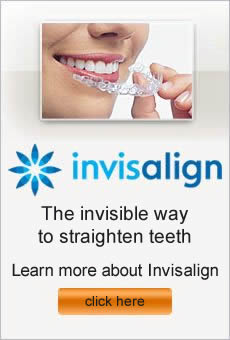If you or a loved one would like a flawless smile, modern orthodontic care offers various treatment options. Patients can decide on dental therapy that suits their needs and budget. Understanding the different choices will help you make an educated decision about your orthodontic care. If you have any questions, make sure to talk with your orthodontist before making any final decisions.
Traditional Metal Braces
A long-standing form of treatment, metal braces are still a popular choice, especially for kids. At our office, we offer GAC in-ovation-braces self-ligating braces. These braces have smaller brackets than traditional metal braces, and require less trips to the orthodontist with faster results.
Clear Brackets
For patients who don’t like the look of metal braces, we offer in-ovation-braces C (clear) brackets. These translucent brackets blend in with your teeth coloring so that they are less noticeable. These braces are designed to resist staining and the self-ligating brackets result in fewer office visits and shorter treatment time over traditional braces.
Invisalign Clear Braces
For adult and older teen patients, Invisalign clear braces offer an easy, inconspicuous way to straighten teeth. The Invisalign system uses a series of clear, custom aligners to gradually shift your teeth in just 12 to 18 months.
Mehdi Fotovat, DDS. Sherman Oaks California orthodontics – we care about you and your smile!
After you finish corrective orthodontic therapy, your treatment probably won’t end. Most orthodontists recommend retainers for their patients. Because teeth have a tendency to shift back after treatment, this orthodontic device helps keep your teeth in the right position. Your orthodontist will determine how long you need the retainer for successful results, but patients often wear retainers for 12 to 24 months.
A retainer can be fixed or removable. As well, your retainer may be clear plastic or attached to a light-colored base with metal wires. Often, the top retainers can be taken out, but the ones for bottom teeth are cemented in place for the duration of treatment.
Once your braces come off, your orthodontist will take impressions of your teeth and use these molds to generate your retainer. Initially, you may need to wear your retainer at night and during the day. Your orthodontist will monitor your progress and adjust that schedule accordingly.
When you have a retainer, it’s important to take proper care of your appliance. Remember to:
• Keep the appliance in a safe place. You will probably receive a case, so make sure to put the retainer away when you aren’t wearing it.
• Clean your retainer. Part of good oral hygiene is brushing or soaking your appliance to remove germs and bacteria.
• If it breaks, contact your orthodontist right away. Don’t try to fix the retainer yourself because you may do more damage.
• Take your removable appliance out to eat or brush.
If you’re looking for an Orthodontist in Sherman Oaks CA, contact us to schedule a consultation. Dr. Fotovat – Burbank Orthodontist – WebBraces.com
If either you or your child needs braces, you should schedule a visit to an orthodontist. At this appointment, the orthodontist can examine your mouth and make recommendations for treatment. Much of the terminology may seem confusing. The following list of terms should help you understand orthodontic basics.
Arch wire
Attached to your brackets, this metal wire helps shift your teeth into the correct position.
Biomechanics
A term that describes the relationship between the force you apply to your teeth and how they move or change.
Crowding
An orthodontic problem that occurs when you have too many teeth in too small an area and results in overlapping teeth.
Dentition
Often used by dentists and orthodontists, this is a term for teeth, gums, and bone.
Fixed appliance
When orthodontic devices are cemented to your teeth, they are considered fixed appliances.
Interceptive orthodontic treatment
Also called Phase 1 treatment, interceptive orthodontic treatment is often performed on patients 6 to 10 years old. The goal of early treatment is to address issues that respond best to therapy while a child is still growing. A second phase of treatment may be needed later.
Malocclusion
The general term used to describe bite problems.
Palatal expander
Sometimes necessary in orthodontic therapy, a palatal expander will make your upper jaw wider.
Retainer
Either a fixed or removable device, a retainer is an orthodontic appliance that will help keep your teeth in the desired position after you finish corrective orthodontic treatment.
Wax
The clear material placed over braces to keep the metal from irritating your gums and mouth.
Giving our patients something to smile about at our Sherman Oaks, CA orthodontic practice – Mehdi Fotovat, DDS.
Getting braces can be quite an adjustment. Because treatment typically lasts for 18 to 24 months, you need to plan on having your braces with you for some time. Knowing what to expect, how to care for braces, and other helpful information will ensure that you maximize your orthodontic treatment.
Eating and Braces
In general, you can eat plenty with braces. You do, however, need to avoid sticky foods like caramel, chewy foods like licorice, hard foods like nuts, and foods you have to bite into like corn on the cob. Feel free to much out on yogurt, pasta, diced chicken, green beans, bananas, and other easy-to-chew options.
Dealing with Discomfort
After the initial placement, your teeth and mouth may feel tender, which is perfectly normal. This discomfort will pass in a couple of days, after you get used to the braces. You may also experience some soreness after an adjustment.
Loose Brackets and Wires
Sometimes, wires and brackets become dislodged or break. If this happens, contact your orthodontist right away. You can place wax over the broken area to prevent irritation in your mouth.
Playing Sports
Having braces won’t stop you from going out for basketball, football, or your favorite sport. To protect your mouth, most orthodontists recommend a mouth guard, which covers your teeth and gums.
Caring for Your Teeth
During orthodontic treatment, it is really important that you practice good oral hygiene. Braces can make you more susceptible to problems like tooth decay and gum disease. Remember to brush after each meal, floss once a day, and see your dentist for routine exams.
We care about your smile at our Sherman Oaks, CA orthodontic office – Mehdi Fotovat, DDS.
You may not realize it, but certain bad habits can be detrimental to your dental health. While it may not seem like nail biting or chewing ice are big issues, they can have definite consequences on your smile. Breaking these habits now can prevent more damage later, as well as save you time in the orthodontist’s chair and extra expenses.
• Thumb sucking
For infants and toddlers, thumb sucking is a method of self soothing. Problems arise when children continue that habit past kindergarten. At that time, permanent teeth being to erupt and thumb sucking can affect their position, which may create orthodontic issues.
• Brushing too hard
Gum recession and loss of supporting bone can occur when you scrub your teeth in full power mode. If you aren’t sure about proper brushing techniques, ask your dentist or hygienist.
• Clenching and grinding teeth
Also called bruxism, teeth grinding and clenching is usually a subconscious response to stress. Often, people clench and grind their teeth at night time. Prolonged bruxism can result in cracked teeth, headaches, sore muscles, and limited function. Your orthodontist can fit you for a night guard to prevent bruxism.
• Chewing ice
A common habit, chewing ice, or using teeth as scissors, puts tremendous strain on your teeth and may cause fractures, cracks, or complete tooth breakage.
• Nail biting
Not only does nail biting introduce germs into your mouth, but it can also weaken tooth strength and create gaps between teeth, which may increase your odds of needing orthodontic treatment.
Consider our Orthodontic team in Sherman Oaks California – Dr. Fotovat – Burbank Orthodontist – WebBraces.com



